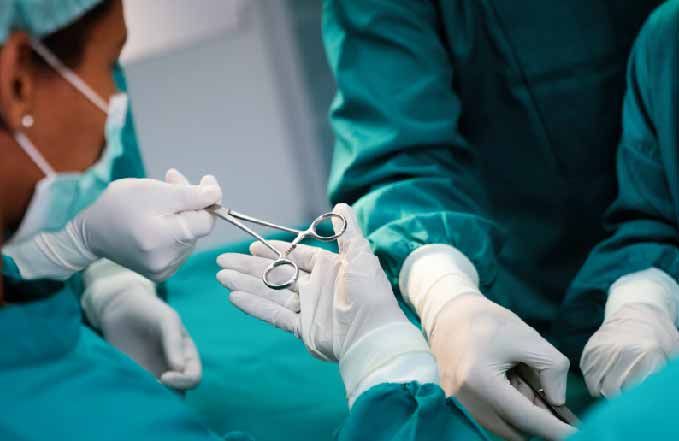脊柱側湾症は、背骨の異常な湾曲を特徴とする病状です。重症の場合、湾曲を矯正し、症状のさらなる進行を防ぐために、脊柱側弯症の手術が勧められることがあります。手術は効果的な治療法ですが、手術に伴う潜在的なリスクや合併症を理解しておくことが重要です。この記事では、感染症、神経損傷、出血、インプラントの不具合、脊椎固定術の不具合、痛みの持続、可動性や機能の喪失など、脊柱側湾症手術に伴うリスクについて包括的に説明します。

側湾症手術とは?
脊柱側湾症手術は脊椎固定術としても知られ、背骨の異常な湾曲を矯正することを目的としています。手術では、金属製のロッド、フック、スクリュー、またはワイヤーを使用して背骨をまっすぐにし、影響を受けた椎骨を融合させます。この癒合により、さらなる湾曲が防止され、背骨が安定します。脊柱側弯症の手術は通常、湾曲が40度を超える重度の脊柱側弯症患者に勧められます。 1.

術前の評価と準備
脊柱側湾症の手術を受ける前に、患者さんは術前に徹底的な評価を受け、全身の健康状態と手術の適性を評価されます。この評価には、身体検査、病歴の確認、X線、MRIスキャン、CTスキャンなどの診断検査が含まれます。外科医はまた、手術の潜在的なリスクと利益について患者さんとそのご家族と話し合い、手術とその潜在的な合併症について明確に理解していただきます。 2.

潜在的リスクと合併症
感染症
感染症は、脊柱側湾症手術を含む、あらゆる外科手術に関連する潜在的なリスクです。感染のリスクは、患者の全身状態、手術手技、術後のケアなどの要因によって異なります。感染症は手術部位や脊椎周囲の深部組織で起こる可能性があります。感染の症状には、発熱、発赤、腫脹、切開部位からの排液などがあります。感染の拡大を防ぐには、抗生物質による迅速な治療が重要です。 3.
神経損傷
脊柱側弯症の手術中には、感覚障害や運動障害につながる神経損傷のリスクがあります。手術中に脊髄の神経が圧迫されたり傷つけられたりすることで、痛みや脱力感、しびれ、麻痺が生じることがあります。神経損傷のリスクは、複雑な症例や背骨の湾曲が激しい場合に高くなります。外科医は神経損傷のリスクを最小化するために細心の注意を払いますが、患者が知っておくべき潜在的な合併症であることに変わりはありません。 4.
出血と貧血
脊柱側湾症の手術は大がかりな手術であるため、かなりの出血を伴うことがあります。外科医は手術中の出血を最小限に抑えるための対策を講じますが、それでも患者は失われた血液を補うために輸血を必要とすることがあります。過剰な出血は、赤血球数の低下を特徴とする貧血を引き起こす可能性があります。貧血は疲労、脱力感、息切れの原因となります。回復を成功させるためには、綿密なモニタリングと出血および貧血の適切な管理が不可欠です。 5.
インプラントの失敗
脊柱側弯症の手術では、金属製のロッド、フック、スクリュー、ワイヤーを使用するため、インプラントが破損する危険性があります。これらのインプラントは、癒合の過程で脊柱に安定性と支持を与えるように設計されています。しかし、時間の経過とともに折れたり、緩んだり、移動したりすることがあり、矯正効果が失われ、合併症の可能性もあります。インプラントの不具合により、インプラントの交換や修復のための再手術が必要となる場合があります。 6.
脊椎固定術の失敗
脊椎固定術の失敗とは、脊柱側弯症の手術で起こりうる合併症のひとつで、脊椎固定術がうまく椎骨を結合させることができないというものです。その結果、脊柱側弯症の矯正が失われ、側弯症が進行し続ける可能性がある。癒合不全の要因としては、骨の質の低下、喫煙、感染、手術手技の不備などが挙げられます。固定術を成功させるためには、再手術が必要になることもあります。 7.
持続する痛み
脊柱側湾症の手術は、背骨の異常な湾曲に伴う痛みを和らげることを目的としていますが、患者さんによっては、手術後に痛みが持続したり、新たに痛みが生じたりすることがあります。これは、神経の損傷、湾曲の残存、またはその他の要因によるものです。持続的な痛みに対処するには、薬物療法、理学療法、代替療法を含む効果的な疼痛管理戦略が必要な場合があります。 8.
移動または機能の喪失
まれに、脊柱側弯症の手術によって、可動性や機能が失われることがあります。これは、手術によって神経損傷、脊髄損傷、筋力低下などの合併症を引き起こした場合に起こる可能性があります。可動性や機能の喪失は、患者のQOLに大きな影響を与える可能性があり、機能回復のために追加の介入やリハビリテーションが必要になることもあります。 9.
結論
脊柱側湾症の手術は、潜在的なリスクや合併症を伴う複雑な手術です。背骨の異常な湾曲を矯正し、生活の質を向上させるという手術の利点は非常に大きいものですが、その一方で、患者さんは手術に伴う潜在的なリスクを理解することが不可欠です。医療チームと密接に協力することで、患者は十分な情報を得た上で決断を下し、脊柱側湾症手術に伴うリスクを最小限に抑えるための適切な対策をとることができます。
参考文献
- Weinstein SL, Dolan LA, Cheng JC, et al. "Adolescent idiopathic scoliosis.". ランセット.2008;371(9623):1527-1537: 10.1016/S0140-6736(08)60658-3.
- Negrini S, Donzelli S, Aulisa AG, et al. "2016年SOSORTガイドライン:成長期の特発性側弯症の整形外科的治療とリハビリテーション治療". 脊柱側湾症と脊椎疾患.2018;13:3: 10.1186/s13013-018-0175-8.
- Trobisch P, Suess O, Schwab F. "Idiopathic scoliosis". ドイツ芸術協会.2010;107(49):875-883: 10.3238/arztebl.2010.0875.
- Hresko MT.「臨床の実際。思春期の特発性側弯症" N Engl J Med.2013;368(9):834-841: 10.1056/NEJMcp1209063.
- Bettany-Saltikov J, Weiss HR, Chockalingam N, et al. "Surgical versus non-surgical interventions in people with adolescent idiopathic scoliosis.". Cochrane Database Syst Rev.2015;2015(4). doi: 10.1002/14651858.CD010663.pub2.
- 社会保障庁。"障害者給付" https://www.ssa.gov/benefits/disability/.
- Lonstein JE, Carlson JM."未治療の特発性側弯症における成長期のカーブ進行予測" J Bone Joint Surg Am.1984;66(7):1061-1071: 10.2106/00004623-198466070-00008.
- Kaspiris A, Grivas TB, Weiss HR, Turnbull D. "Scoliosis:診断と治療のレビュー". 国際整形外科ジャーナル.2013;37(1):34-42: 10.1038/s41390-020-1047-9.
- Monticone M, Ambrosini E, Cazzaniga D, et al. "Active Self Correction and task-oriented exercises reduces spinal deformity and improve quality of life in subjects with mild adolescent idiopathic scoliosis:ランダム化比較試験の結果" 欧州脊椎学会.2016;25(10):3118-3127: 10.1007/s00586-016-4625-4.
- Kotwicki T, Negrini S, Grivas TB, et al. "Methodology of evaluation of scoliosis, back deformities and posture"(側弯症、背中の変形、姿勢の評価方法)。 脊柱側湾症.2009;4:26. doi: [10.1186/1748

